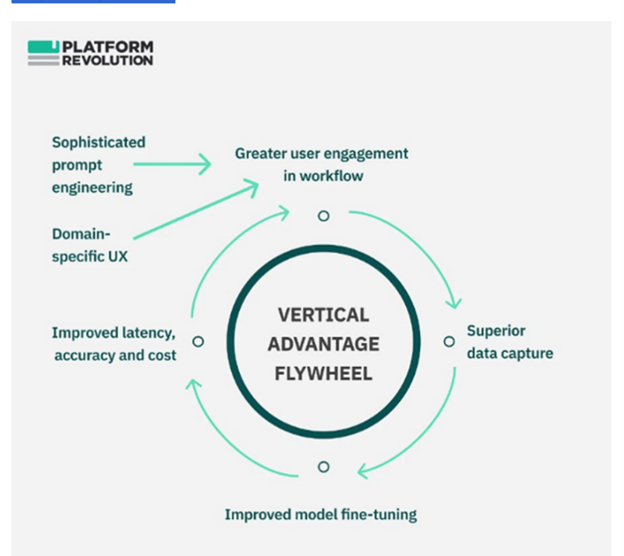The concept of a flywheel came out of physics and engineering – but it pops up in business strategy fairly regularly.
In engineering, it’s a mechanical device that uses conservation of angular momentum to store rotational energy. So, it’s like a capacitor. But it stores rotational energy instead of electrical energy. Something like this.

Flywheels are usually thought of as a device that spins frictionlessly almost forever, with little required help.
In business, it’s the idea of a self-reinforcing loop. Where each turn of the wheel builds upon the last, creating momentum and (in theory) progress over time. We are looking for a situation where two or more operating activities in a business interact in a way that fuels continuous improvement.
And usually in business the image you see is something like this.

This graphic is from Sangeet Choudary’s discussion of AI flywheels. It’s from an article he wrote on Substack.
What Are the Benefits We Can Get with an Operating Flywheel?
The big benefit everyone talks about is Sustainable Growth. That by creating a self-reinforcing cycle, a flywheel can enable a business to achieve growth that is sustainable and scalable.
But that is only half of it.
We want growth with big Operational Efficiencies. Want it to be frictionless, like the wheel that just keeps spinning without much. So, we want growth to be cheap and to almost happen on its own. And we achieve this by linking operating activities synergistically so they can coordinate.
However, flywheels aren’t necessarily about growth. That is just the big one everyone wants. We can see lots of other benefits. For example, we can see flywheels that result in:
- Customer Loyalty: Many flywheels are designed to enhance customer value and satisfaction, leading to increased loyalty and retention over time. With little effort.
- Data-Driven Insights: We can see continuous feedback loops that provide valuable data and insights that can then be used to optimize the system and improve performance. In fact, most of what people call Data Network Effects (which I don’t believe in) are actually operating flywheels.
You can (in theory) have operating flywheels in any part of an operating model.
But Operating Flywheels Are Different than Network Effects
Flywheels and network effects are distinct concepts, though both can contribute to business growth. And they can overlap at times as concepts.
- A flywheel is a mechanism in an operating model. It is when two operating activities create a self-reinforcing loop where they build on each other and create momentum and improve a metric (often growth) over time. It relies on linkages between operating activities, such as when sales and marketing or data collection feed into product development.
- A network effect is a competitive advantage where the product or service itself becomes more valuable as more people use it. There is a direct relationship between the size of the user base size and the value provided to each user. This value creation per marginal user can be a bit complicated.
I generally think of flywheels as an operating model and network effects as a business model. Although, it can get confusing because network effects can have 4 different effects.
- Network effects cause an increase in the real or perceived value and/or utility to customers. As mentioned, the product or service that increases in value to the user. This is usually what people are talking about with network effects. A couple of sub-points:
- This is usually thought of as effect on consumers or business customers. But it can also be for other user groups, like content creators and developers.
- Network effects based on utility are easy to understand. Think communication networks like WhatsApp. Or payment systems. These are usually commodity services.
- Network effects based on “value” can be more complicated. Value can be real or just perceived. It can be everything from having more videos to watch (YouTube). Or just having the perception of a more common language to use or community or tribe to join.
- Network effects doesn’t necessarily mean growth. You can have a great and improving service in a small or flat market.
- Network effects can increase economic value. This is not the same thing as increasing customer value (real or perceived), which is how it is perceived. If a platform business model has attractive unit economics and growth potential, then you can see increasing economic value and shareholder returns with network effects. But not always. You can have a fantastic service with increasing customer but not economic value (by network effects)
- Network effects can create a competitive advantage. This is demand side economies of scale. This is what often collapses the market to a monopoly or oligopoly. However, this also doesn’t necessarily mean the creation of economic value. You can dominate an unprofitable business. And it doesn’t necessarily mean growth. You can dominate a stagnant business.
- Network effects can create a barrier to entry. In digital businesses, this is mostly by indirect network effects, which have a chicken and egg problem. That barrier makes it hard for new entrants to break in. There is actually less of a barrier to entry with direct network effects. Although we do see barriers to entry in physical networks which require lots of tangible assets. For example, replicating a railroad is almost impossible in a developed country.
The biggest differences between flywheels and network effects are:
- Nature: Flywheels are operational, emphasizing how a company executes its activities. Network effects are structural, inherent to the product or platform itself.
- Advantage: Flywheels can be helpful but are not typically a source of competitive advantage on their own. Network effects can create significant competitive advantages.
- Scale: Network effects usually require a large number of users or participants to be effective, often hundreds of thousands or millions. Flywheels can function effectively with smaller user bases by improving internal efficiencies.
Three Examples of Flywheels
Flywheels can take various forms depending on the specific goals and activities of a business. Here are three common types of flywheels that I have talked about before:
1. Sales and Marketing Flywheel (i.e., HubSpot)
This flywheel focuses on attracting and engaging customers to drive sales and revenue growth. This is usually what everyone is after when talking about flywheels.
HubSpot is a good example of a company that has successfully implemented a sales and marketing flywheel.
As discussed in previous posts, HubSpot specializes in providing customer relationship management (CRM) software to businesses, particularly small and medium-sized enterprises (SMEs).
And it has a big focus on inbound marketing techniques to attract visitors to its own business. The techniques are called “inbound” because they try to attractive customers to come to the site. Usually by content creation, SEO, social media, and email newsletters.
Inbound marketing is also a big part of the major service it sells to its clients. In fact, the entire business was founded on the concept of inbound marketing – which the founder wrote up in a book called Inbound Marketing.
It looks like this:

Basically, it is doing lots of marketing. And to a lesser degree direct sales. Which then attracts customers into its software services, which have recurring revenue and switching costs.
Which brings me to their flywheel.
HubSpot also has a solutions partner network that it uses to amplify its marketing and sales efforts. These partners, often local service firms or agencies, advise enterprise customers on how to implement HubSpot’s software. They effectively become an external marketing and sales force.
These partners receive commissions for referrals, creating a recurring revenue stream for them and aligning their interests with HubSpot’s growth. That’s the sales and marketing flywheel, which looks like this.

Past customers who use their services become marketing agents for the business. And some do actual sales of HubSpot services and get a commission and recurring revenue.
- They convert delighted customers into Promoters.
- And they convert some customers into Solutions Partners.
- Promoters and especially Solutions Partners help them get more clients.
- Which repeats the process.
HubSpot combines this flywheel with their inbound marketing activities. That’s pretty powerful and is how they have achieved global growth in SMEs (which is not easy).

2. Developer or Limited Ecosystem Flywheel (i.e., HubSpot and Baidu AI)
A developer or limited ecosystem flywheel is about creating a platform or limited ecosystem that attracts developers who want build applications and integrations for the service. This enhances the value of the core product. Which attracts more customers. Which attracts more developers.
This is a self-reinforcing loop:
- The more developers integrate with a product, the better the product.
- The better the product, the more customers.
- Which in turn attracts more developers.
The benefits of a developer flywheel are:
- Enhanced Product Value: Integrations from other developers make the core product better and more attractive to customers.
- Increased Customer Acquisition: A wider range of integrated apps can attract more customers.
- Platform Growth: As the platform grows, it becomes more attractive to developers, further expanding the ecosystem.
This sounds a lot like a network effect. And it kind of is.
But I think it is sort of subscale. We are not talking about hundreds of thousands or millions of developers. We are talking hundreds or thousands of developers. Which is too small to be an innovation platform. It’s closer to a limited ecosystem, which are really common.
An example of this is HubSpot which offers a limited ecosystem of complementary apps and integrations. There are around 1,500 apps that can be integrated into their system. It looks like this.

I’ve talked a lot about consumption ecosystems. How adding services can make a product or service better, often solving more of the customers problem.
But these are often done through partners. And doing this with developers and integrations is particularly effective. So, I call this a developer or limited ecosystem flywheel.
Another example of this is Baidu AI Cloud.
Baidu has a growing suite of big foundation models and deep learning platforms for developers. It offers these tools and resources to developers so they will build AI applications based on their foundation models. This growing suite of apps makes the Baidu platform more attractive to customers. Which attracts more developers.
They are trying to create a self-reinforcing cycle of innovation and growth. Today, this is a limited ecosystem flywheel. But they are definitely going for an innovation platform and network effect if they can get big enough.
What is particularly interesting about this case is that Baidu’s AI Cloud strategy is focused on building industry-specific intelligence. They are also trying to create flywheels in AI intelligence. Especially industry-specific intelligence in manufacturing, finance, and transportation. Here is how they describe it.

Which brings me to the big question of the moment.
3. AI Knowledge Flywheels (i.e., Baidu AI Cloud)
This is the big question. And the point of this article (sort of).
Can you create a knowledge flywheel with AI?
Can you create an operating system where model intelligence, performance, and efficiency increase with industry application and usage?
This is the core of Baidu’s AI Cloud strategy.
They are betting that with more users, use cases, apps, APIs, and data coming from industry usage, their models will get more accurate and efficient. And these more intelligent and efficient models will then encourage more usage, apps, and use cases.
It’s a flywheel strategy.
They are combining industry-specific knowledge graphs and massive amounts of industry-specific unstructured data, coming from on-the-ground industrial use.
And two operating activities in the flywheel are “knowledge enhancement” and “industrial-level application”.
That’s really cool in theory. But is this true in practice?
Does this work as a flywheel long-term? Or is it just a short-term effect?
Is this leading to a new type of network effect? On a new type of platform business model?
I’m not sure.
Right now, I view it as an AI knowledge flywheel that is effectively fueling their growth and adoption.
- If it only lasts a short time (i.e., the other models will catch up), then I view it as a temporary effect.
- If it only lasts a long time (i.e., the other models can’t catch up), then I view it as a new type of flywheel.
- If it keeps happening at large scale, then I consider it a network effect.
We’ll see.
McKinsey & Co has long talked about how machine learning can be a flywheel. Here is their standard graphic.

This is clearly not true in simple topics like spell check and translation.
But this may be true for complicated topics like manufacturing.
Baidu’s Kaiwu “Smart Manufacturing Platform” is an example of this. They are attempting to improve the quality and efficiency of factories by having superior industry-specific knowledge in their AI-powered solutions.

***
Ok. That’s most of what I wanted to talk about.
Last Point: Here Are Key Considerations for Building a Flywheel
- Identify Core Activities: Determine the key activities that drive your business and have the greatest impact on growth.
- Map the Cycle: Visualize how these activities interact and reinforce each other in a continuous loop.
- Optimize Each Component: Focus on improving the efficiency and effectiveness of each component of the flywheel.
- Measure and Monitor: Track key metrics to monitor the performance of the flywheel and identify areas for improvement.
- Invest Strategically: Allocate resources strategically to fuel the flywheel and accelerate its momentum.
Cheers, Jeff
———–
Related articles:
- A Digital Strategy Breakdown of Salesforce. Spoiler: It’s Awesome (1 of 3) (Tech Strategy – Daily Article)
- Is GenAI Disrupting Salesforce? The Rise of Intelligent CRM? (Tech Strategy – Podcast 215)
- A Strategy Breakdown of Arm Holdings (1 of 3) (Tech Strategy – Daily Article)
From the Concept Library, concepts for this article are:
- Flywheel
- Network Effects
From the Company Library, companies for this article are:
- HubSpot
- Baidu AI Cloud
——-–
I write, speak and consult about how to win (and not lose) in digital strategy and transformation.
I am the founder of TechMoat Consulting, a boutique consulting firm that helps retailers, brands, and technology companies exploit digital change to grow faster, innovate better and build digital moats. Get in touch here.
My book series Moats and Marathons is one-of-a-kind framework for building and measuring competitive advantages in digital businesses.
This content (articles, podcasts, website info) is not investment, legal or tax advice. The information and opinions from me and any guests may be incorrect. The numbers and information may be wrong. The views expressed may no longer be relevant or accurate. This is not investment advice. Investing is risky. Do your own research.
